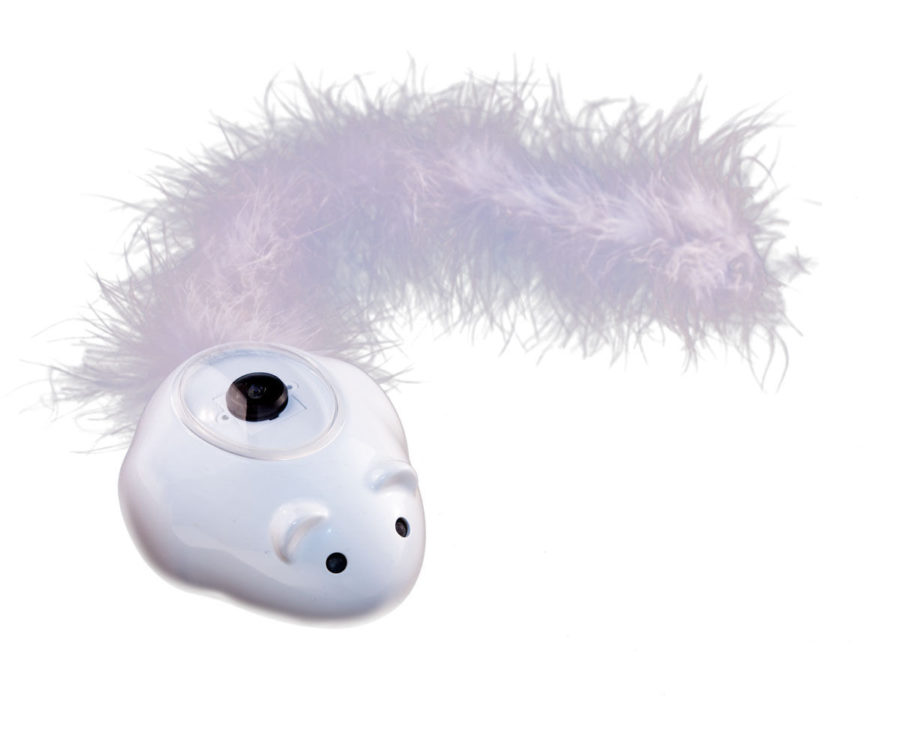UI alumni develop robotic mouse toy
Mousr now has 360 degree vision, eyes that change color to indicate its mood or battery level as well as interchangeable tails, and there are hopes for even more improvement.
December 1, 2014
Cats are natural hunters. When they are cooped up inside a house that does not let them hunt, they may become agitated and behave in ways that are hostile to their owners and others around them.
To combat this problem, three electrical and computer engineering graduate students have created a robotic mouse called Mousr.
The modern cat toy is the first product of a start-up company called Petronics, founded by ECE students Michael Friedman, Dave Cohen and David Jun.
Friedman said the mouse will behave like a real mouse, giving cats the chance to behave the way they naturally would.
“This gives them a chance to really hunt something that moves with intelligence as opposed to something like current electronic toys that just sit and spin around randomly,” Friedman said. “And, it’ll move according to how the cat chases it.”
Get The Daily Illini in your inbox!
After attending a four-month crash course in China, the group built the first prototype in 2013, which they introduced to their own cats.
Jun said Mousr is actually aware of its surroundings, something that electronic toys have never been able to do.
According to Cohen, the cat can feel like it is hunting, as opposed to when it plays with its owner.
“Even when you play with your cat you’ll get them a lot more excited, but our belief is that they still know that they are playing,” Cohen said. “It’s still not the same thing as hunting because they can see you playing, and it’s a game for them.”
The students agree that the project has required more than just engineering. Particularly, the group said business and marketing are what will help Mousr thrive.
To help push Mousr into the global market, Petronics is using Kickstarter, which allows them to raise funds from the public by advertising the device online.
With its Kickstarter, Petronics hopes to gain sufficient funding for its project to further develop it.
As of print time, the team has reached their goal of $100,000 in funding with almost 800 backers on the project and five days left of the campaign.
The website includes background information about the device, the progress the design has made so far and photos to advertise the product, along with a video showing the latest product, and a sadly hilarious series of depressed cats with their current toys.
According to the website, Mousr is “the most engaging cat toy ever built. Period.”
Kickstarter incorporates a concept called crowdsourcing, which brings together thousands of users to work toward a large goal that would be impossible for an individual.
“None of us have this kind of cash,” Jun said. “But if you open it up to the Internet, and a thousand people can donate $10 or $20, and all of a sudden you would get the kind of capital you need to make this a reality.”
Since advertising their device online, Cohen said they have found Mousr is something people want to support.
“Being able to see all these people who we don’t know looking at this thing and putting down a hundred dollars or more for a toy for their cat is really cool and it’s validating what we’re doing, and we’re really onto something that people want to see in their homes,” Cohen said.
Other ECE graduate students, such as Andres Guzman-Ballen have supported the project through donations and hope to see it grow.
“By having a robot that would actually respond to the way a cat behaves would be much more fun for the cat interacting,” Guzman-Ballen said. “I have a lot of hope for what the device is going to be.”
Petronics hopes to continue to stay based in Champaign because of the numerous resources available at the University.
Cohen said the community at the University is “very approachable” and works to “make things happen.”
As for future plans, Cohen said they hope to further develop the device and incorporate artificial intelligence so it will be able to interact not only with cats, but also with humans.
Fatima can be reached at [email protected].







